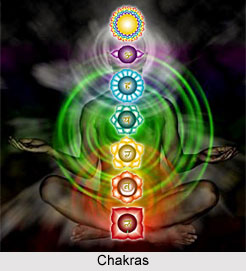 Chakras, as a theory, occur in Tantric and yogic traditions of both Buddhism and Hinduism. The name Chakra is derived from the word "Wheel". Chakra is also referred to wheel-like vortices. Chakras are a source of energy that permeates from a point on the physical body. The vortices are considered the focal points for the reception and transmission of energies. There are 7 chakras in total. However there are several chakras on a human body.
Chakras, as a theory, occur in Tantric and yogic traditions of both Buddhism and Hinduism. The name Chakra is derived from the word "Wheel". Chakra is also referred to wheel-like vortices. Chakras are a source of energy that permeates from a point on the physical body. The vortices are considered the focal points for the reception and transmission of energies. There are 7 chakras in total. However there are several chakras on a human body.
In the Upanishad texts, the chakras have been mentioned. The energy of these vortices arrives from one"s own Kundalini, another being the spiritual force within an individual. These energies come from inside the body and flows out the chakras. One experiences energy from other people. Spiritual energy, Prana and other energies around humans may also flow in through the chakra centres.
Concept of Chakra
People, who are less matured in their evolutionary growth, incline to bring out much more energy than they emit out. When people are weak then they pull in energy from developed people. One"s practice includes giving. An individual "gives" energy from their chakras. Lending is an act that strengthens a person whereas when energy is pulled out from an individual, one can be weakened. There are some people who absorb energy from others.
Those people, who are not spiritually developed, may be open to negative forces. A person who is dejected inclines to put energies coming through the chakras on a depressed level. This intensifies troubles. Evolved people have more energy flowing out of their chakras than inside. As they become more richly developed, the Kundalini energy growing from their chakras coalesces with divine energy, continues to exude out, then curves back to come in through the hands and feet (occasionally through other areas of the body), bringing an assortment of these energies into them.
Working of Chakras
The chakras help an individual to attain greater understanding of the several energy frequencies which reins or influences one"s physical, emotional, mental and spiritual states. During purification, one will find that fears and problems from this life and other lives may be locked or blocked at specific levels. One may also find joys or grand times which do not incorporate and were not released into the body cells, correspondingly blocked in the energy pattern. Occasionally fear of the future will be apparent. It is suggested to the followers of Kundalini to begin by letting the energy flow directly out in front of their bodies rather than spin. Several times all of the petals are not fully developed and spinning only twists the energy.




















